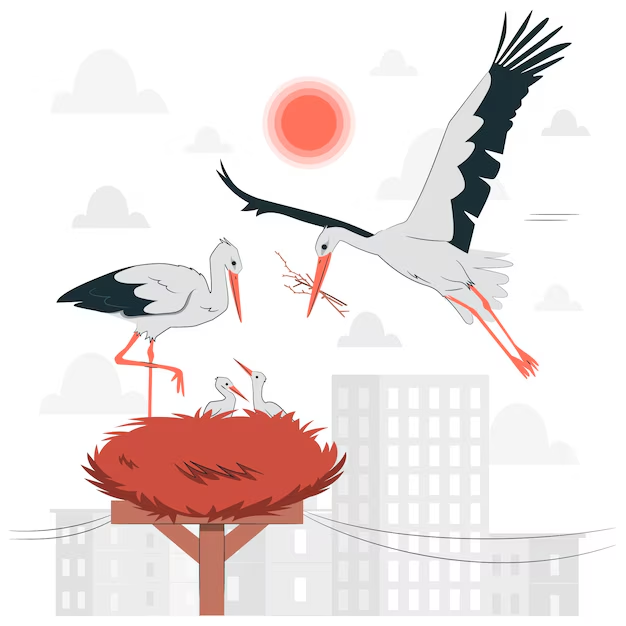Storks are huge, elegant birds recognized for their spectacular migrations, different lengthy legs, and hanging beaks. They have captured the fascination of people for centuries, not only for their physical traits but also for his or her cultural significance and tremendous migratory behaviors. These majestic birds can be located in various environments around the sector, from wetlands to grasslands, and have been the situation of myths, legends, and scientific have a look at.
In this text, we’ll discover the biology, behavior, and cultural impact of storks, shedding mild on why those birds are each superb and revered by people.
Overview of Storks: Family and Species
Storks belong to the family Ciconiidae, which incorporates around 19 species unfold across the globe. They are most normally observed in Europe, Asia, Africa, and the Americas. While all storks percentage certain traits, including lengthy legs and necks, big wingspans, and robust beaks, they vary in length, color, and habitat preference.
Common Stork Species:
- White Stork (Ciconia ciconia) – Perhaps the maximum famous stork species, the white stork is thought of for its white feathers, black wing guidelines, and crimson legs and beak. This species is extensively identified across Europe and Africa.
- Black Stork (Ciconia nigra) – A more elusive species, the black stork is characterized by darkish, iridescent plumage. It is usually determined in forests and wetlands in Europe, Asia, and elements of Africa.
- Jabiru Stork (Jabiru mycteria) – Native to the Americas, the Jabiru is one of the largest stork species, with a tall, implementing presence and a wonderful black-and-white shade pattern.
- Marabou Stork (Leptoptilos crucifer – Known for its big size and exceptional bare head and neck, the marabou stork is usually found in sub-Saharan Africa.
Storks are recognized for their graceful flight, often soaring high in the sky using thermals to drift lengthy distances without flapping their wings excessively.
Physical Features and Adaptations
Storks are constructed for flight and feeding, with numerous capabilities that allow them to thrive in diverse environments:
- Long Legs and Neck – Storks have lengthy legs and necks which can be nicely perfect for wading via shallow waters to catch prey like fish, amphibians, and bugs. These adaptations additionally help them on their migratory journeys, as they can cover huge distances without tiring without difficulty.
- Large Beaks – Their long, pointed beaks are designed for catching and greedy prey in wetlands and muddy regions. They are exceedingly efficient hunters, often visible status nonetheless in the water and awaiting fish or small animals to return close to.
- Strong Wings and Soaring Ability – Storks have large, long wings that help them soar throughout huge distances during migration. They are known for their splendid ability to journey hundreds of miles among breeding and wintering grounds.
Migration: A Long Journey
One of the most charming factors of storks is their migratory behavior. Many species, especially the white stork, adopt lengthy migrations among their breeding grounds in Europe and their wintering grounds in Africa. These migrations can span lots of miles and take several weeks. Storks depend on thermals (growing warm air currents) to benefit altitude and drift for lengthy distances, preserving power at some stage in their journeys.
Migration is an important part of stork lifestyles because it allows them to discover meals throughout distinct seasons and keep away from harsh winters. They usually return to the same breeding grounds year after year, making their long trips a vital issue of their lifestyle cycle.
Breeding and Nesting: Family Life of Storks
Storks are regarded for their remarkable nest-building capabilities. They typically build huge, cumbersome nests in tall trees, on rooftops, or maybe on man-made structures together with energy poles or chimneys. These nests are crafted from sticks, twigs, and different available substances, and they may be reused and added to year after year, resulting in massive, multi-layered systems.
During breeding season, storks perform complicated courtship shows, which often involve synchronized dancing, calling, and beak-clattering. Once a couple is bureaucratic, they work together to elevate their chicks. Both parents take turns incubating the eggs and feeding the chicks when they hatch. Storks are dedicated mothers and fathers and are regarded to shield their young fiercely until they’re geared up to fly and go away from the nest.
Cultural Symbolism of Storks
Storks were embedded in the human way of life and mythology for centuries, regularly symbolizing crucial topics inclusive of family, fertility, and new beginnings.
- Mythology and Folklore – In European folklore, storks are regularly associated with childbirth. The famous myth that storks deliver infants originated from historical ideals, and the hen has become an image of new life and motherhood. In some cultures, it is the notion that storks deliver top luck, especially to families hoping to have kids.
- Cultural Significance – In addition to being symbols of fertility and birth, storks also are respected for their migratory habits. In some cultures, the chook’s annual return marks the appearance of spring and the renewal of life.
- Storks in Art and Literature – Storks are regularly featured in art, literature, or even famous children’s books and cartoons. Their swish moves and majestic presence have made them a popular situation for artists and writers in the course of history.
Conservation and Threats
While storks are substantial, a few species are going through threats due to habitat loss, weather change, and human interest. Wetland drainage, deforestation, and urbanization all pose good-sized challenges to stork populations, as these birds rely upon healthy ecosystems for breeding and feeding.
Efforts to guard storks include habitat maintenance, education programs, and developing synthetic nesting platforms for species like the white stork. Organizations and governments around the sector are running to make certain that these iconic birds continue to thrive in their natural habitats.
Conclusion: The Enduring Charm of Storks
Storks are captivating birds that preserve a long-lasting location in each of the herbal world and the human way of life. Their swish flight, surprising migrations, and robust family bonds lead them to a symbol of resilience and beauty. As protectors of their younger and key players in ecosystems around the sector, storks maintain to encourage awe and surprise, from their migration journeys to the memories that have been informed approximately them for generations.
Whether visible hovering excessively inside the sky or nesting in tall timber, storks continue to be a captivating part of our world, representing both the cycles of nature and the timeless topics of family, fertility, and new beginnings.











